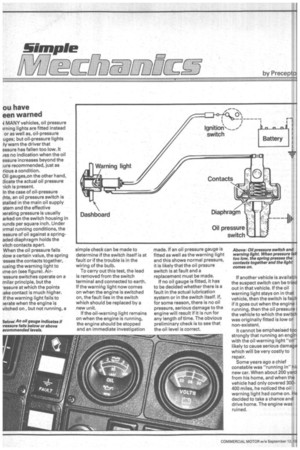ou have een warned
Page 26

If you've noticed an error in this article please click here to report it so we can fix it.
J MANY vehicles, oil pressure !ming lights are fitted instead or as well as, oil-pressure uges; but oil-pressure lights ly warn the driver that assure has fallen too low. It res no indication when the oil essure increases beyond the ure recommended, just as rious a condition.
Oil gauges,on the other hand, dicate the actual oil pressure lich is present.
In the case of oil-pressure ihts, an oil pressure switch is stalled in the main oil supply stem and the effective mrating pressure is usually arked on the switch housing in )unds per square inch. Under )rmal running conditions, the essure of oil against a springaded diaphragm holds the vitch contacts apart.
When the oil pressure falls )low a certain value, the spring .esses the contacts together, 'using the warning light to ime on (see figure). Air-essure switches operate on a milar principle, but the -essure at which the points lake contact is much higher. If the warning light fails to )erate when the engine is vitched on , but not running, a
simple check can be made to determine if the switch itself is at fault or if the trouble is in the wiring of the bulb.
To carry out this test, the lead is removed from the switch terminal and connected to earth. If the warning light now comes on when the engine is switched on, the fault lies in the switch which should be replaced by a new unit.
If the oil-warning light remains on when the engine is running, the engine should be stopped and an immediate investigation made. If an oil pressure gauge is fitted as well as the warning light and this shows normal pressure, it is likely that the oil prssure switch is at fault and a replacement must be made.
If no oil gauge is fitted, it has to be decided whether there is a fault in the actual lubrication system or in the switch itself. If, for some reason, there is no oil pressure, serious damage to the engine will result if it is run for any length of time. The obvious preliminary check is to see that the oil level is correct. If another vehicle is availablf the suspect switch can be tried out in that vehicle. If the oil warning light stays on in that vehicle, then the switch is fault if it goes out when the engine i running, then the oil pressure i the vehicle to which the switch was originally fitted is low or non-existent.
It cannot be emphasised too strongly that running an engin with the oil warning light "on" likely to cause serious damage which will be very costly to repair.
Some years ago a chief constable was "running in" hi; new car. When about 200 yard: from his home, and when the vehicle had only covered 300400 miles, he noticed the oil warning light had come on. He decided to take a chance and drive home. The engine was ruined.








































































